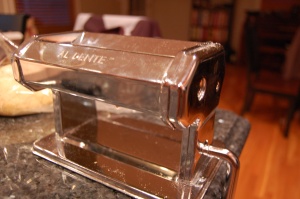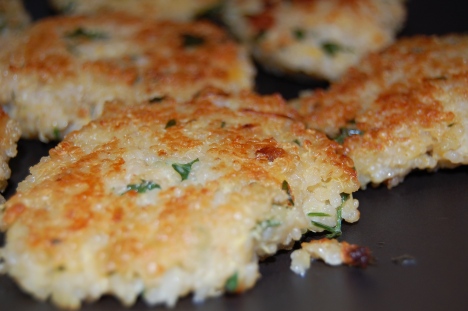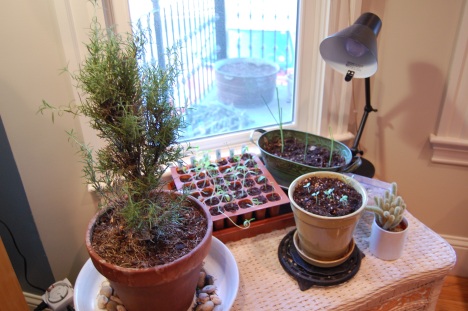
You may recall that a few weeks ago I attempted to make spinach gnudi with no success. I was missing a key ingredient (flour) which would have helped them stay cohesive in the boiling water. Not wanting to be wasteful, I took the gnudi batter (here) and placed it into a ziploc bag and into the freezer it went. Last night, I finally found a use for that batter – it makes an excellent ravioli filling.
With some time to kill (ok, a few hours) on a Saturday night, I made some fresh pasta dough using the following recipe, which yielded about 50 small ravioli. You could just use wonton wrappers instead but where’s the fun in that ?!:
2 cups semolina flour
2 cups durum flour
2 eggs
1/2 cup water
pinch of salt
Mix the flours and salt in a large bowl, then make a small well in the center. Add the eggs and the water to the well. Slowly, using a fork, beat the eggs and water together, then begin incorporating a little flour mix into the egg mixture until a dough starts to form. Continue incorporating flour until the dough begins to dry, the knead the dough to incorporate additional flour until it is fairly solid and not too sticky (about 5 minutes). You will still have a lot of flour left in the bowl, so don’t try to incorporate it all. You’ll need the leftover flour for the rolling out of the dough. Once you’ve finished making the dough, wrap it in plastic and place it in the fridge for at least 30 minutes. When you are ready to roll it out, remove it from the fridge and allow it to come to room temp. Here is what the dough should look like:

I highly recommend getting a pasta dough lesson from an experienced maker, because the only way to know if this is right is to feel it. The humidity, size of the eggs, etc, will all affect the dough so it is a little tough to get right the first time. The dough should be good and elastic but not too sticky. If you are in the Boston area, Dave’s Fresh Pasta in Davis Square, Somerville, is an excellent place to take a lesson.
When the dough is ready to go, cut off a piece to work with, maybe 3-4 inches long and an inch thick. You will need a pasta machine for this recipe, as it is very difficult to roll it thin enough by hand. I use an Al Dente pasta machine, hand crank, and I find it really works great. It came with an attachment to make spaghetti, linguine, etc, so I use it whenever I am making pasta.

You will need a surface to clamp the pasta maker to, and large enough space to roll out the pasta sheets. You’ll also want a pasta rack (or something to hang the pasta sheets on) so that your sheets can dry out a bit after you roll them:

To roll out the pasta sheets, set the pasta maker on it’s widest setting (7 on my Al Dente machine). Take your piece of dough and flour it lightly on both sides with the leftover durum/semolina mix. Run it through the machine. Dust it again on both sides, fold it in half and run it through again on the same setting. Repeat one more time. After you have run it through 3 times on the widest setting, set the machine 1 setting lower, and run the dough through. Continue to run it once through on each lower setting (6,5,4,3..) until you get to about setting 3 on the pasta machine (might be 2 on other machines). You will have a very thin sheet of pasta, a bit thinner than you would use to make spaghetti or linguini. Take the sheet and hang it (see picture above) and roll out the rest of your dough in workable pieces.
Once it’s all rolled out, you are ready to assemble the ravioli. Since we plan on doing this reasonably often, we have invested in a ravioli form, which makes ravioli making infinitely easier and faster:
You don’t really need this gadget but if you plan on being a regular ravioli maker, or even an occasional one, it’s a cheap investment and worth while. If you don’t want to get one, you can just cut the ravioli by hand.

With the ravioli form, you place the dough on top of it (make sure to dust it with flour), place a small spoon of filling in each depression, brush the dough surface with an egg wash (or water) and fold the remaining dough (or another sheet) on top of it. The egg wash (a lightly beaten egg) helps the dough layers to stick together. Take your rolling pin and roll over top of the entire form and then flip over to release the ravioli.
If you are doing this by hand, lay the dough flat on your counter, and place a spoonful of filling about 1/2 apart along one side of the dough. Brush around the filling with the egg wash and then fold remaining dough over top to enclose. Make sure you firmly press all the way around each mound of filling to seal it. Cut into individual ravioli using a knife.
Once all are assembled – we placed each batch on a piece of wax paper which was dusted with more flour – boil a large pot of salted water. Gently place the ravioli in the water and they will take only about 4 minutes to cook.
We topped ours with a light tomato sauce and some parmesan cheese. The ravioli can be frozen right after you make them (we actually froze half the batch), just make sure they are well floured so they don’t stick together in the freezer. If they are frozen when you cook them, they will just take a few more minutes to cook in the boiling water:

Filed under: Carb-a-licious, Classics, Random Bag Night, Vegetarian (or easily made that way) | Tagged: durum, pasta dough, pasta maker, pasta rack, ravioli, ravioli form, recipe, semolina, spinach | 3 Comments »















